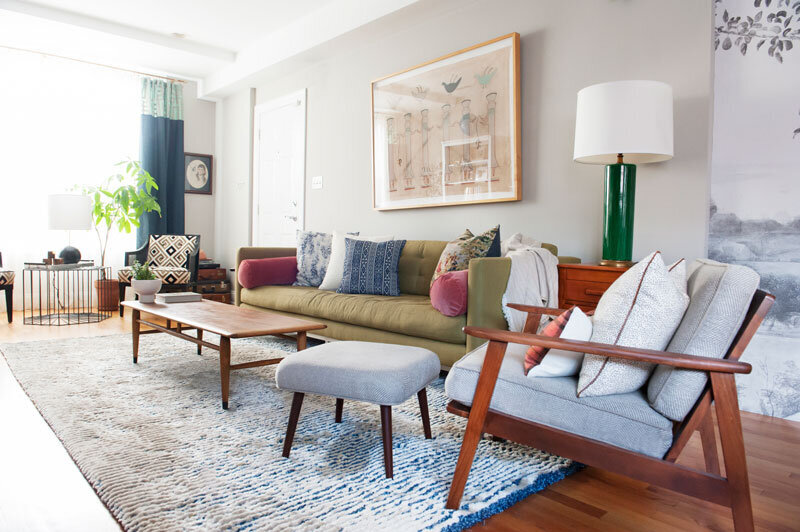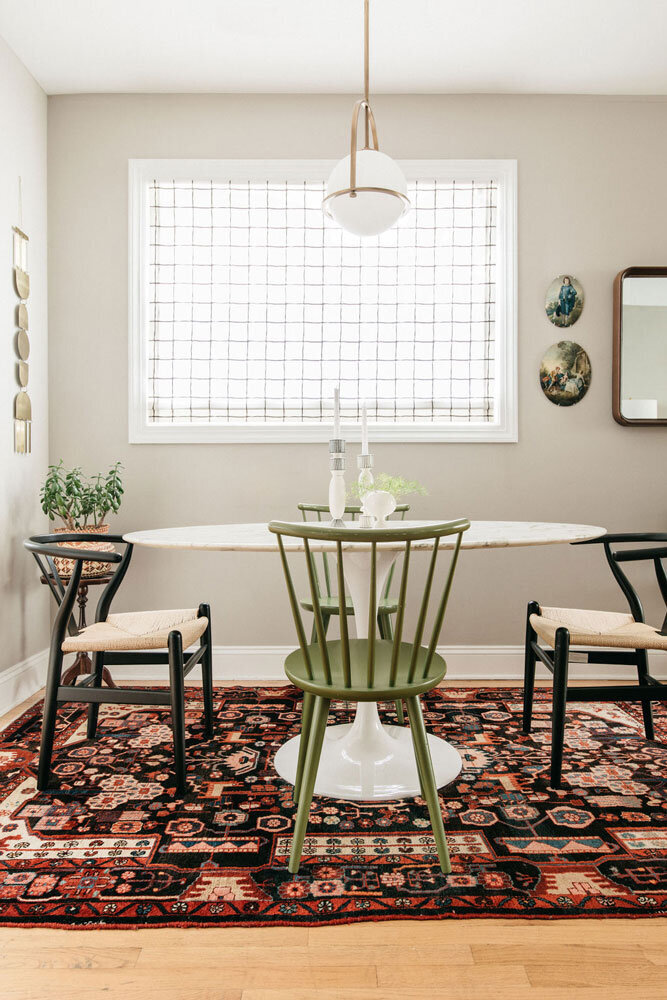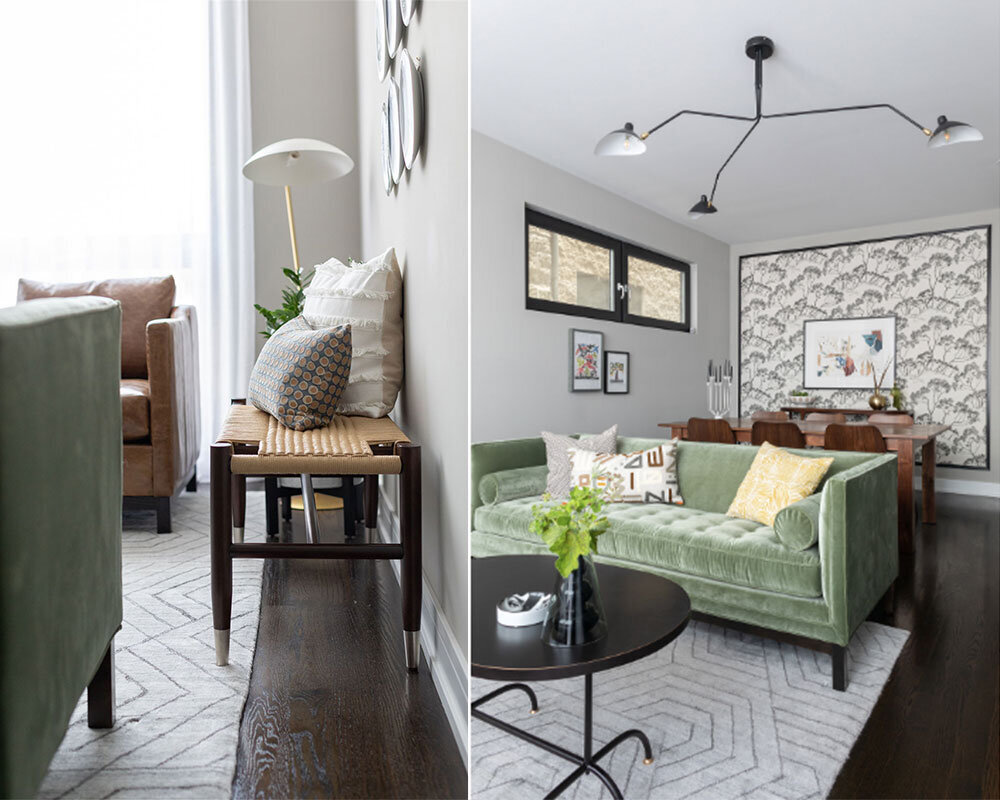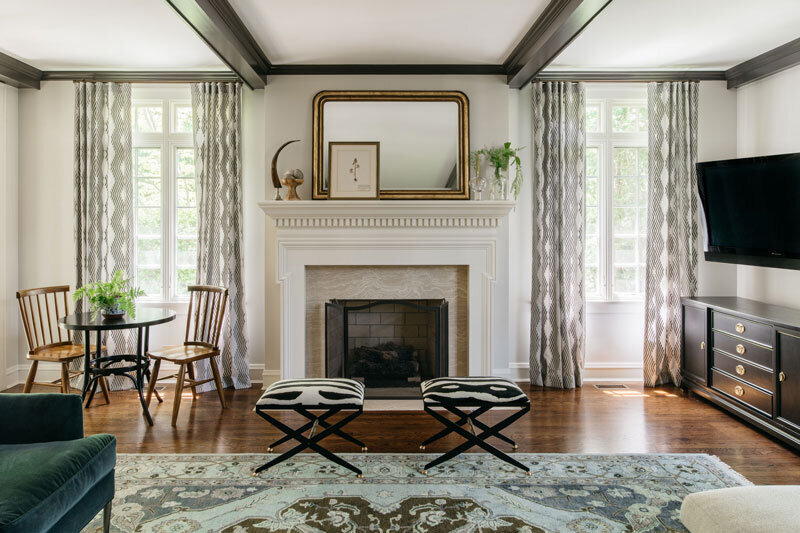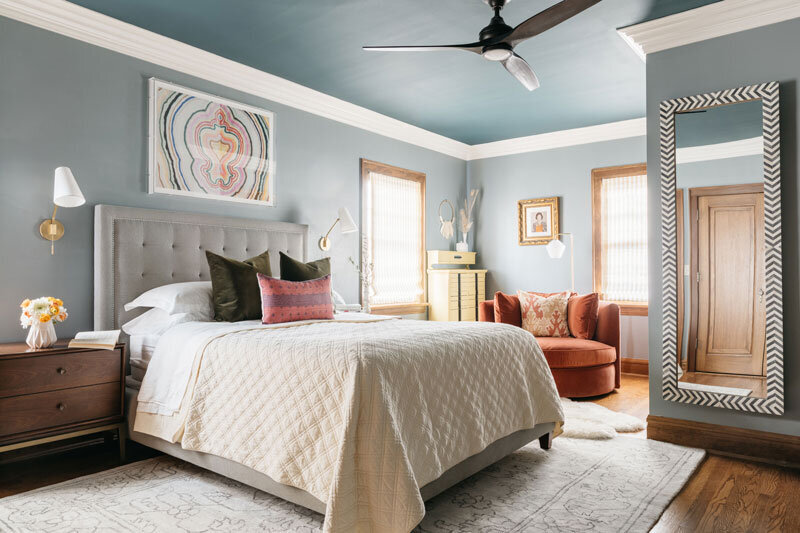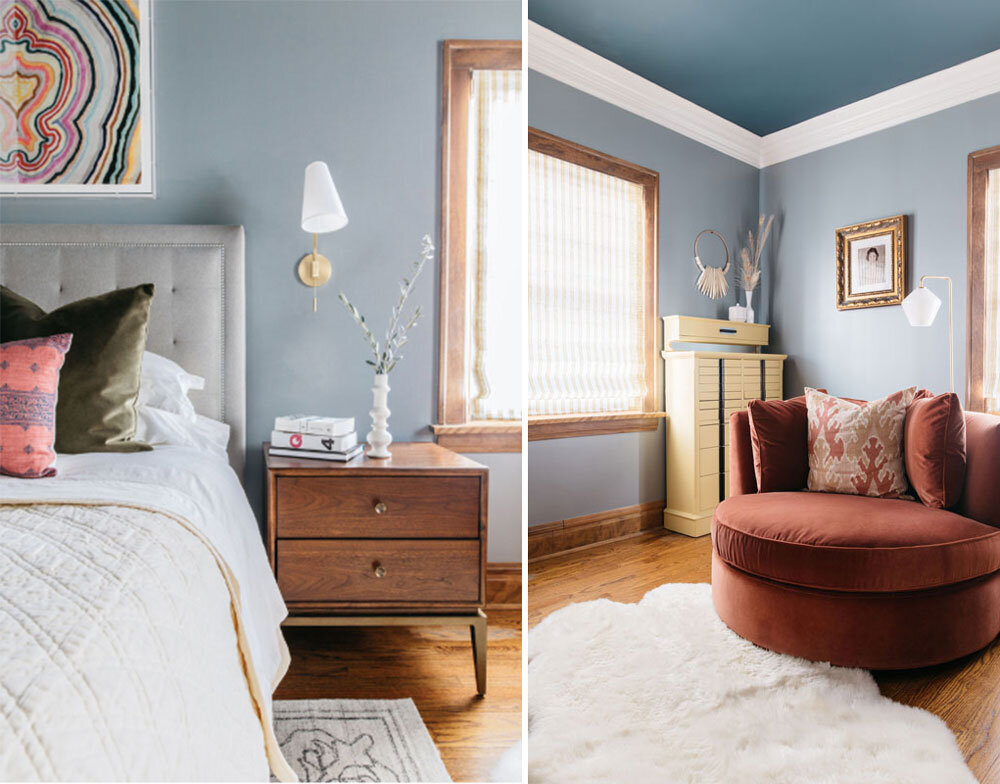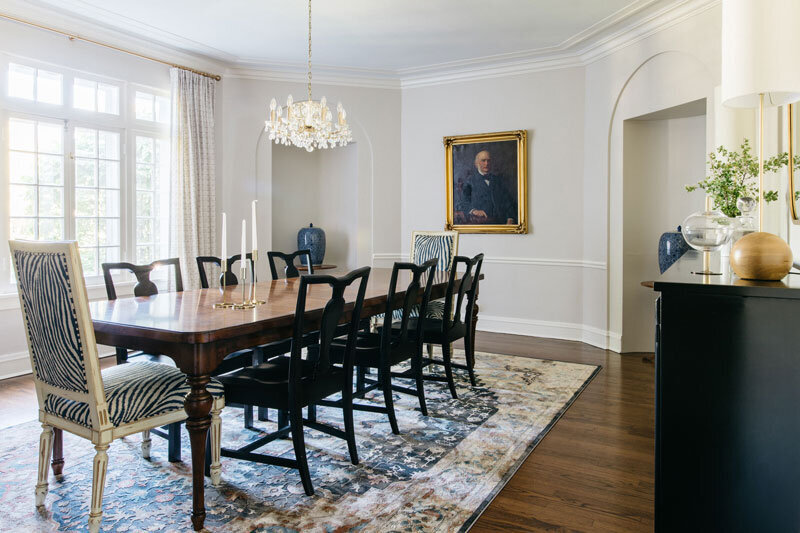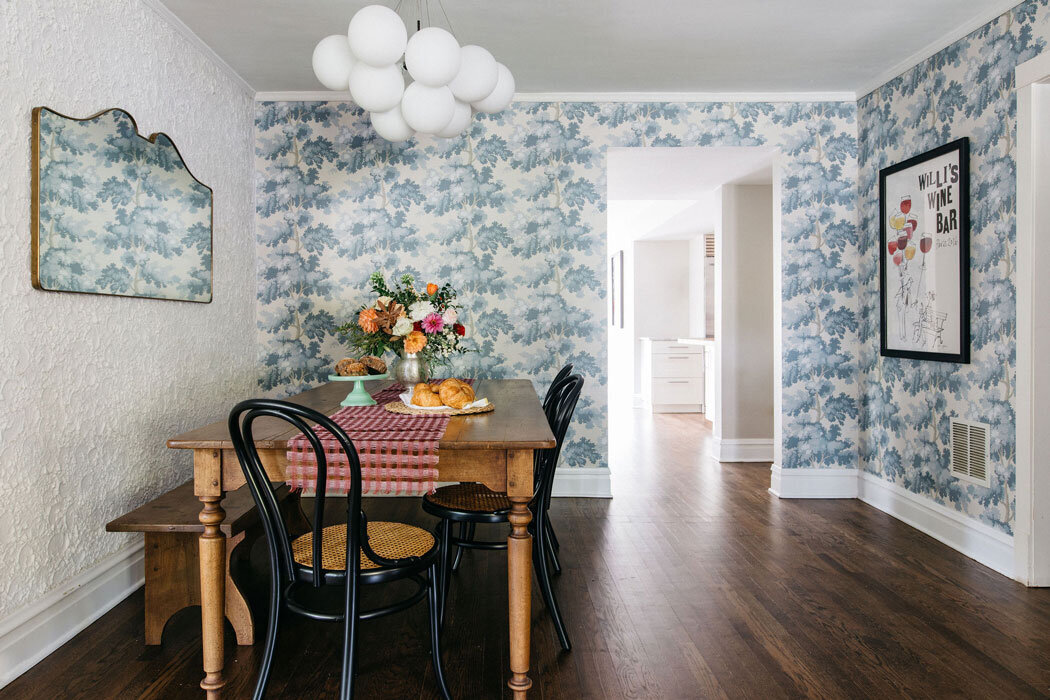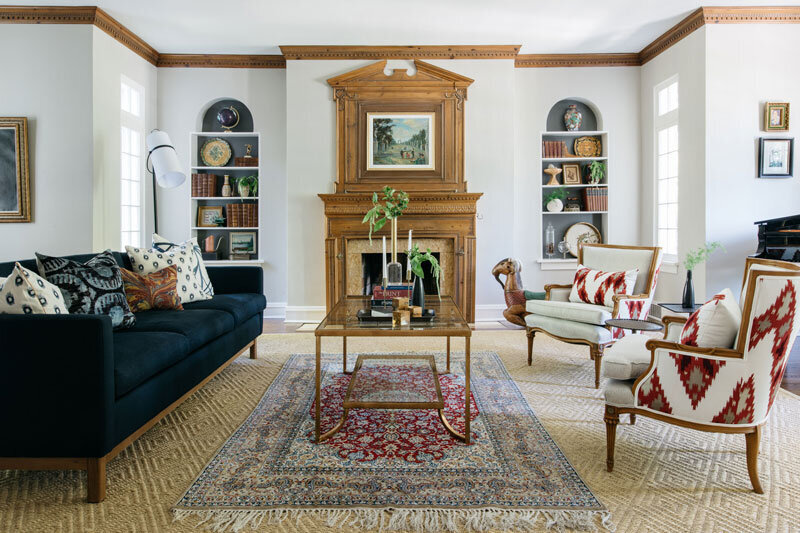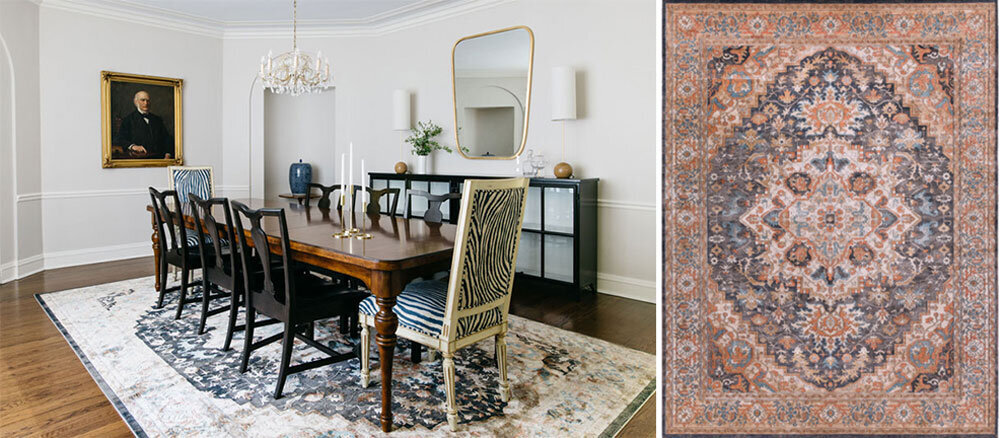How to Choose the Right Size and Material Area Rug
Choosing the right rug for your space can be a great starting point for your room design or it can be the necessary addition that softens the room, grounds your furniture and gives you a finished space. Whether you go for a statement rug or you are looking to replace one you have, there are many variables to choosing the correct size and material of rug.
The correct rug size for a room is a common question and there is no shortage of articles out there on the subject. In this post I’ll give you my insight and walk you through how I guide my clients in selecting the right size and material rug for a room.
7.5’ X 11’ rug in a long and narrow room. photo by Paper and Pate Interior Photography.
Rugs come in pretty standard sizes and the general rule of thumb is to go as big as you can. A 5x8 is usually too small for a living, family room or bedroom. An appropriate place for a 5x8 might be under a twin bed, in a small seating area away from a sofa or under a 60” long or less dining table. 6x9 rugs can work in small rooms with petite furniture, like under a sofa that is less than 80”.
5.5’ X 8.5’ vintage persian rug under a 60” long oval table. photo by Margaret Rajic.
An 8x10 is a decent sized rug that can work in most medium sized rooms. It’s good to keep in mind that most furniture should not be flush with the walls unless you are extremely limited on space. The same goes for a rug. I like to keep at least a foot of space between the edges of the rug and the wall. When determining whether an 8x10 will work for your space, measure the inside of your seating area. The front legs of all of the furniture should land on the rug. Also remember the best way to orient a rug is in the same way the room is oriented.
8x10 Viscose area rug in 14’ X 22’ living/dining room. photo by Gene Yoon.
A 9x12 rug is the way to go if space allows. If all four legs of the furniture can be on the rug and there can still be space between the wall and the rug, it’s the right choice. It can be tempting to size down when you see a few hundred dollar price difference. That may hurt for a minute, but a too small rug will hurt you every day!
9’ X 12’ wool rug in a large living room. photo by Margaret Rajic.
Placing a rug in a bedroom is a bit trickier and there are some additional things to consider. It’s hard to stomach investing in a rug which the majority of will be hidden and trapping dust under the bed, so I’ve also got some creative solutions to share. A 5x8 rug never looks right under a queen bed so you need at least a 6x9 if the room is on the smaller side, ideally an 8x10. This may be a personal preference, but I always think it looks better for rugs under beds to be oriented lengthwise perpendicular to the bed if space allows. It’s also important to get the placement right the first time, it’s not easy moving a rug around under a bed.
8’ X 10’ Viscose rug placement under bed. Photo by Margaret Rajic.
The room pictured above had an odd shape to accommodate a bathroom so I chose to orient the rug with the majority on the left side. The alternative would have been to have most of the rug under the bed and that would literally make me feel like I was choking. I incorporated a flokati rug to fill out the right side of the bed and ground the chair.
Hopefully we’ve all had the opportunity to put our feet on a cushy carpet or rug as we take our first steps in the morning and we know how hard and cold the alternative is. If space or budget doesn’t allow for a larger rug under the bed, you could consider a 3x5 or 4x6 for one or both sides. I think this is also a better option if you have two feet or less between the foot of the bed and the wall. To keep things a little more organic in texture and shape I think a Flokati or hide rug can look nice next to a bed. This is also a good option to add a design element if your room is carpeted.
We filled out the space on the right side of the bed with a Flokati Rug. photo by Margaret Rajic.
Deciding on whether you want a rug under your dining table also has several variables. You may wonder if it’s even necessary at all! You should consider the size of the table and if it has leaves how often they are in. You will want the rug to extend at least 24” around all sides of the table. I suggest staying away from thick or high pile rugs and would even forego a rug pad for ease of walking around and getting in and out of your chair.
If the room is large and you don’t have a lot of other furniture or architectural elements like windows, I would almost always suggest a rug under the dining table. The dining room generally doesn’t have much by way of upholstery, so drapery and rugs can help soften the space and break up all of the hard surfaces. It can also help you extend the footprint of the dining table in a large room so you need less in the way of additional furniture.
9’ X 13’ Polyester Rug. photo by Margaret Rajic.
Alternatively, if you use all upholstered chairs, the table material has some contrast to the flooring and you’ve got interest on the walls with drapery, wallpaper or a dramatic paint color, you can get away without a rug. OR if you are at the stage in your life where you have young kids or drunk dinner guests, forego the rug and don’t feel bad about it!
For a rug to be centered under this dining table it would have to be a custom size. photo by Margaret Rajic.
Once you’ve got the rug size you need down, you will need to consider the material of your rug. Wool or other natural material rugs are by far the most durable and easy to clean. Wool rugs are either hand tufted, hand knotted or flat weave. I always prefer a hand tufted or hand knotted rug over a flat weave. Flat weaves are made on a loom, like fabric, and are a much lower price point. If you do choose a flat weave it’s a good idea to use a rug pad and rug tape to keep it from shifting and bubbling up.
8’ X 10’ low pile wool rug. Photo by Margaret Rajic.
It’s not always easy to tell from a photo what the construction is, you may only notice the price difference. It’s important to look at a closeup of the rug and read the product description when shopping online. I like Rugs USA because of their large selection and you can filter by material and size. It can also be informative to read product reviews, you may learn that a rug shows up a different color than it appears online
Jute and sisal rugs can be great for price point and a more casual look. They are a natural material, so can be durable depending on the construction. If you get one that is on the less expensive side it generally has a looser weave and can be prone to shifting and snagging. They can also come with a lot of dust and dirt depending on where the material came from and how well it was cleaned before construction. Sisal splinters are a real thing! This is one type of rug I would suggest getting samples of or shopping for in person. There is such a variety in texture, it’s good to know ahead of time what it feels like. Tighter weaves that come with a backing will stay in place and last much longer.
10’ X 14” sisal rug with backing and binding around the edge. Photo by Margaret Rajic.
Viscose is another common material in rugs, either on its own or blended with wool or silk. Viscose has a beautiful sheen and great depth of color, but is not very durable. I recommend viscose rugs in low traffic areas, like formal living rooms or bedrooms. If it’s blended, the more wool content the more durable. 100% viscose rugs are generally comparable in price to wool, but the viscose blends tend to be more expensive.
100% Viscose rug. Photo by Gene Yoon.
Synthetic fiber rugs such as Nylon, Olefin (polypropylene) or polyester are also common options. These rugs are durable to an extent, but do not have the longevity that wool does. Many rugs are advertised as indoor/outdoor and those are made from Olefin. This material is resistant to fading and has moisture repelling qualities. These rugs are soft, but are low pile and have a synthetic sheen to them. They almost always look different in person from online because of this. I sometimes source these for clients when the room and budget are appropriate, but I make sure I have seen them in person first.
You can see the difference from the web photo and what the 85% Polyester 15% Polypropylene rug looks like. photo by Margaret Rajic.
There are as many rug options as there opinions on the matter, but I hope you’ve found the information on this post helpful. I do think rugs should be considered an investment as much as upholstered furniture and window treatments so it’s important to do your research before deciding the size, style and material rug best suited for your space. I’ve got much more to share on the subject of style, how to layer rugs and how to go about shopping for vintage rugs. A rug is essentially one big textile and can be filled with lots of color and pattern so naturally I just love them! What else would you like to know about rugs?

